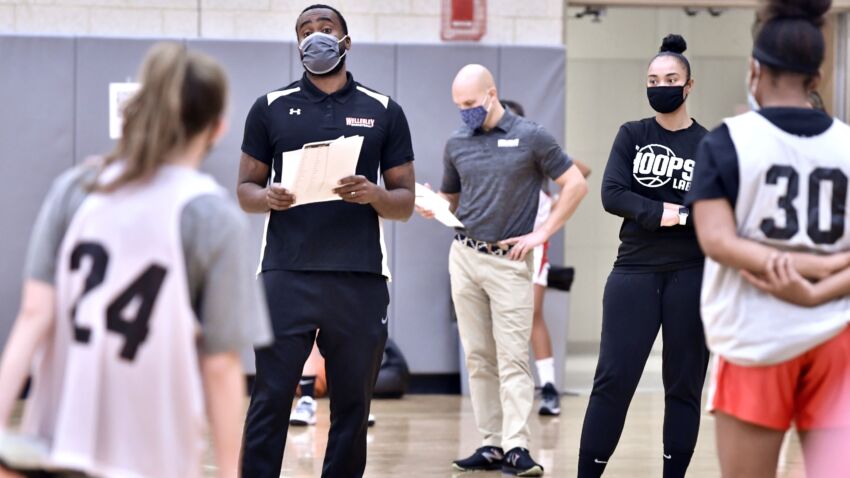The way the fall unfolded proved that – despite many expected challenges and hiccups along the way and the glaring absence of football and cheerleading – it is possible to complete a high school sports season during a pandemic.
This winter, as teams and leagues around the state try to replicate that feat, they do so knowing that winter sports will provide some additional hurdles. The most obvious is that every winter sport takes place indoors, whereas just volleyball was inside in the fall. Data suggests athletes will be more susceptible to catching COVID-19 inside than they were outside, and it’s likely that programs will once again have to shut down periodically as cases arise.
Another complication, of course, is that numbers are spiking around the state, and it appears the vaccine won’t be ready for the general public before winter ends. Many programs have already elected to skip the winter season entirely, while many others got underway Monday with the first day of tryouts.
“The pandemic has reshaped the way education is delivered across the country and the same can be said about its impact on athletics,” MIAA President Jeff Granatino said in a release. “Nonetheless, I am confident our student-athletes and coaches will adjust to the new expectations this winter and have an experience as fulfilling and as exciting as what we saw during the fall season.”
The MIAA has gotten approval to run basketball, hockey, swimming and diving, gymnastics, and alpine and nordic ski. There will be no MIAA state tournaments this winter, but it’s possible some leagues could have postseason substitutes like they did in the fall.
Indoor track has been moved to the Fall II season set to start in late February, and wrestling has been moved to the spring season slated to begin in late April.
While the sports that do happen this winter should provide a major lift to the psyche of athletes around the state, the new rules and regulations will certainly take some getting used to.
Here’s a sport-by-sport breakdown of how they’ll look.
Basketball
The Franklin girls’ basketball team was one win away from potentially punctuating an undefeated season with a Division 1 state title last winter, but the Panthers never got that chance as the pandemic forced the season to come to a screeching halt.
Franklin coach John Leighton said that it was “a thrill” to return to practice Monday, particularly after such a sour ending to a magical run a year ago.
“My now seniors, who were juniors, have been chomping at the bit waiting to get back on the floor, worried whether they’d even have a season,” Leighton said. “Who knows what’s going to happen down the road? That’s one thing my team’s learned, that it can change at any minute, but we’re just so glad to be back out there.”
Leighton said practice got underway with sanitation stations, doors open, masks on at all times, and social distancing whenever possible. He knows this will be an unusual experience in many ways, but he and his players firmly believe it’s worth it to do what they love.
Some of the challenges are logistical, such as transportation, and others specifically pertain to the on-court product. For starters, the jump ball will be eliminated, so one team will throw the ball in at mid-court to start the game. There will be no halftime, time between quarters will be increased to two minutes and 30 seconds, and timeouts will be one minute, 15 seconds to allow for extra sanitizing.
Free throw lanes are limited to four players and will remain empty unless a possible rebound is involved. During dead-ball situations, offensive plays in the front-court will start from the free-throw line extended instead of on the baseline. Team representatives will notify officials if they plan to foul at or near the end of the game, and a light tag will replace a wrap-up.
Players should avoid high-fiving, picking one another up, and spitting, and social distancing is encouraged whenever possible. Mask breaks may be necessary if players are breathing heavily, but the consensus is that they’ll have no problem coping.
“At this point, we’ll go through any hoop we need to to get on the court,” Leighton said.
Hockey
The most significant in-game tweak for hockey is that only one defensive and offensive player are permitted in any scrum along the boards. A third participant will result in an immediate stoppage of play, and officials can stop play if a scrum lasts longer than five seconds.
One person is allowed in the penalty box at a time, and teams have to spread out along the bench or allocate a separate area to enforce social distancing.
Team bonding will be more difficult to organically replicate without locker room sessions and typical socializing before and after practices and games.
Of course the absence of a postseason may be the most glaring adjustment of all, but the consensus is that it’s well worth it to get back out there in any capacity after an offseason of doubt and uncertainty.
“Having a hockey season is an experience that I will never forget and will miss after I play my last game,” Duxbury senior Billy Mrokwa said.
Other sports
High school swim meets are typically not an ideal place for curmudgeons or claustrophobes who are averse to boisterous crowds and school spirit.
This season, though swimmers and divers will still be loud and proud, the overall vibe of meets will be different. It appears that many schools are turning to virtual meets, which means they’ll compete against other teams from their own separate pools and submit their results.
While there’s still incentive to win, that format could zap some of the fun out of the overall experience.
Swimmers will also have to un-mask at the proper time when they step onto the starting block and place those masks into zip lock bags. All of the adjustments will take some getting used to but should be doable big picture.
Skiing is the sport least affected by the pandemic, as masks are essentially already built into their equipment and social distancing isn’t too difficult while zipping and zigzagging down a mountain. Skiers will have to get used to life without cozy lodges and adapt to training in pods, but they should be able to do so.
In gymnastics, schools can opt for remote meets as well, and competitions will be dual meets only. Several health protocols, such as hand sanitizing, cleaning equipment, and specifying a designated waiting area, will be in place as well.
Games and events are scheduled to start on various dates around the state throughout the next few weeks, and the winter season is set to end in late February.
Get Boston.com’s browser alerts:
Enable breaking news notifications straight to your internet browser.



















